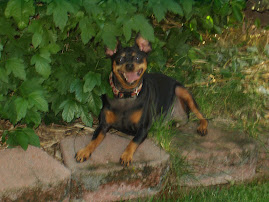


Rat Terrier
Country of Origin: United States
History: The rat terrier was descended from terriers brought over by working class English immigrants, including the smooth fox terrier, Manchester terrier, and now-extinct English white terrier. The rat terrier was bred to control rats, as well as to provide entertainment in the blood sport of ratting. It was later crossed with whippets, Italian greyhounds, and beagles. The breed was popularized by Teddy Roosevelt, who often hunted with rat terriers.
Physical Description: The rat terrier is a small to medium-size, muscular dog that is slightly longer than it is tall. It has a wedge-shaped head and the skull and muzzle are of equal length. The nose is black or self-colored and the eyes are prominent. The ears are button, tipped, or erect and V-shaped. The tail may be docked, naturally long and curved upward, or a natural bob. Coat colors range from solid white to bicolor or tricolor, with white and black, tan, chocolate, blue, blue fawn, apricot, or lemon.
Height (Miniature): under 13 inches
Height (Standard): 13 to 18 inches
Weight (Standard): 10 to 25 pounds, both
Note: The rat terrier description is somewhat convoluted, as different registries have different standards: The UKC recognizes miniatures and standards, as well as hairless rat terriers. The Rat Terrier Club of America recognizes miniatures and standards but not hairless, which they included under another breed, the American hairless terrier. The National Rat Terrier Association recognizes toy, miniature and standards, as well as two body types: Type A - square dog; Type B - longer than it is tall, as well as a larger variety called Decker giants. Also see the Teddy Roosevelt terrier.
Temperament: The rat terrier is an energetic, curious, and intelligent dog. It is game and tenacious when hunting but affable and affectionate at home. It gets along with children, other dogs, and cats.
Activity Level: Moderate
Best Owner: It adapts to most living situations: city or rural, active or sedentary.
Special Needs: Exercise, human companionship, socialization, sun protection, training
Possible Health Concerns: Allergies, bite problems, hip and elbow dysplasia, lusxating patellas, mange


No comments:
Post a Comment